Improving on the weakness of our last brew, the objective for our 4th batch was to reach the target initial gavity. As result, the alcohol content should increase as well as the full body taste.
Just like the last brew, this batch also uses the brew-in-a-bag (BIAB) method of mashing the grains. Realizing the inefficiencies with BIAB, improvement with this batch comes from using finer milled grain and more grain than the recipe requires. A bit more than two pounds of milled two-row malt was added to the required recipe quantity. A 5 pound max postal scale was used to measure the grains and hops.
| Ingredient | Recipe | Actual | Units |
| 2-row pale malt | 14.5 | 16.7 | lbs. |
| Briess Crystal Malt | 1 | 1 | lbs. |
| Magnum Hops | 36 | 36 | AAU |
| Centennial Hops | 16 | 16 | AAU |
| Chinook Hops | 6.5 | 6.5 | AAU |
| Centennial Whole Hops | 2 | 2 | oz. |
| Irish Moss | 1 | 1 | tablet |
| London ESB Ale Wyeast 1968 | 1 | 1 | bag |
| Yeast starter | 2 | 0.65 | Liter |
| Priming sugar | 7/8 | 7/8 | Cup |
And here is how it was brewed…
Step Description 1 Started to heat 3 gallons in 15 gallon kettle to 155F 2 Added grain to 155 F water in bag, heat removed 3 Had additional 3 gallons or so on stove heated to about 175F 4 Added hot water to mash to maintain 149F strike water as temp dropped 5 Stirred every 5 minutes or so during 60 minute mash 6 Sparged, extracting around 4 gallons each time, pouring back slowly through kettle bag 7 Removed bag of grain, squeezing out as much wort as possible. NOTE: Need to use heat-resistant gloves next time 8 Boiled for 90 minutes, adding magnum hops at beginning of boil. Added Irish moss 15 minutes before end of boil 9 Added flame-out hops at end of boil, whirlpool stir and settled for 15 min 10 Put kettle in tub with blue cubes. 3.5 hours before reaching 70F 11 Transfered to fermentor, pulled gravity sample and pitched 650mL yeast starter 12 After two weeks, transferred liquid to bucket, cleaned hops from fermentor, and transferred back to fermentor. 13 Added Dry hops, waiting 7 days. 14 Boiled priming sugar, cooled, and added to transferred liquid. 15 Transferred to one sanitized 22 oz bottle, remainder kegged.
| Step | Description |
| 1 | Started to heat 3 gallons in 15 gallon kettle to 155F |
| 2 | Added grain to 155 F water in bag, heat removed |
| 3 | Had additional 3 gallons or so on stove heated to about 175F |
| 4 | Added hot water to mash to maintain 149F strike water as temp dropped |
| 5 | Stirred every 5 minutes or so during 60 minute mash |
| 6 | Sparged, extracting around 4 gallons each time, pouring back slowly through kettle bag |
| 7 | Removed bag of grain, squeezing out as much wort as possible. NOTE: Need to use heat-resistant gloves next time |
| 8 | Boiled for 90 minutes, adding magnum hops at beginning of boil. Added Irish moss 15 minutes before end of boil |
| 9 | Added flame-out hops at end of boil, whirlpool stir and settled for 15 min |
| 10 | Put kettle in tub with blue cubes. 3.5 hours before reaching 70F |
| 11 | Transfered to fermentor, pulled gravity sample and pitched 650mL yeast starter |
| 12 | After two weeks, transferred liquid to bucket, cleaned hops from fermentor, and transferred back to fermentor. |
| 13 | Added Dry hops, waiting 7 days. |
| 14 | Boiled priming sugar, cooled, and added to transferred liquid. |
| 15 | Transferred to one sanitized 22 oz bottle, remainder kegged. |
April 13, 2018
Today marks two weeks since brew day. The fermentation period has expired and we are now ready to measure final gravity and start the dry hopping. After sanitizing the dry-hopping bucket, the fermented beer container was raised on a high chair for a gravity transfer to the bucket.
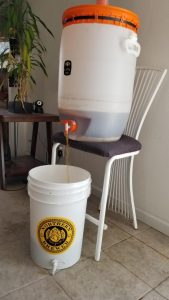
And a sample was drawn for measurement of the final gravity with a hydrometer.
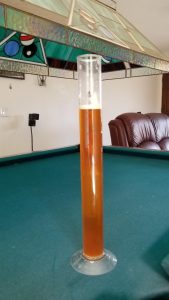
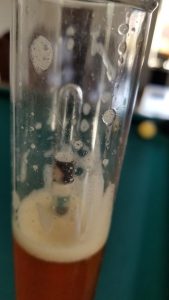
The readings were close to expected:
| Initial Gravity | Final Gravity | ABV | |
| Expected | 1.074 | 1.012 | 8.5% |
| Actual | 1.070 | 1.008 | 8.1% |
Since we did not want to return the gravity sample back to the batch for fear of contamination, it was chilled and consumed to get an idea of the final product.
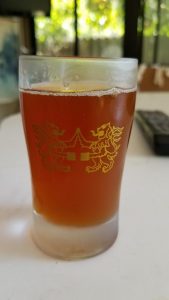
The whole hops were added to the bucket, now we wait a week or so for dry hopping…
April 20, 2018
Today marks the end of dry hopping. Time to prime the beer for carbonation and conditioning. After adding the priming sugar water, I drew off a small 5 oz sample to taste and bottled 22 oz. before transferring the beer to the keg. Now we wait two more weeks for conditioning.
The sample was encouraging. A strong yet smooth finish tells me this batch will be close to what we expect from a Stone Ruination DIPA.
May 4, 2018
The keg was put in the kegorator yesterday to chill for the first pour. There was significant back pressure from the keg from the sugar priming so I decided to draw beer without the CO2 connection to the keg until the pressure diminishes a bit.
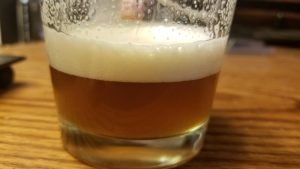
My impression is of a smooth yet potent brew. Got a bit of a buzz after only perhaps 6oz, sample. Yikes! It appears that we have met the objective of this batch; to meet the target gravity
I will wait for Tony to sample later today to get a second opinion.
In our next batch, two improvements are planned.
- Use a reverse-flow wort chiller coil to minimize post boil-to-pitch yeast time.
- Increase yeast starter volume by upgrading to a 2L flask.
Dave.
What a log!!! So detailed and precise. With this document, anyone can brew and avoid the mistakes we all make at first. Awesome job.
So far, this was from memory. From now on, I am going to add the documentation as we go so nothing is forgotten. It will be the good, the bad, and yes, even the ugly.